The annual ALS User Meeting convened October 2–4, bringing together 400 users to share insights from their own research and hear updates about the facility and colleagues’ research. The event, co-chaired by Users’ Executive Committee (UEC) members Francesca Toma and Monika Blum, comprised plenary sessions as well as 13 focused workshops.
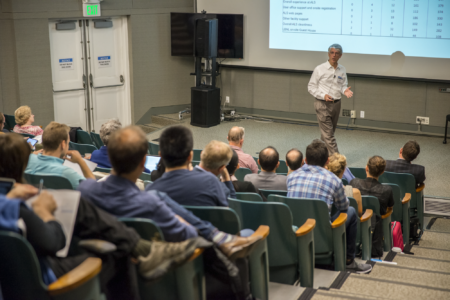
UEC Chair Monika Blum launched the meeting with a welcome, followed by another from Energy Sciences Associate Laboratory Director Jeff Neaton, who referred to the ALS as “the centerpiece of Berkeley Lab.” ALS Director Roger Falcone outlined ALS accomplishments and goals, pointing out that the ALS is seeing a number of increases—in publication numbers, in proposals submitted, and in the amount of data produced by ALS research. Demand is high, but budgets are flat, which makes managing all of these issues particularly challenging, Falcone said.

Linda Horton, Director of Materials Sciences and Engineering for the U.S. Department of Energy Basic Energy Sciences program (DOE-BES), provided a Washington update. Horton noted the importance of light sources within the DOE energy sciences portfolio.
Moving on to budgets, Horton acknowledged that the president’s proposed budget for BES facilities contains a reduction in funding. But Congress’s current marks have all user facilities funded at or near fiscal year 2017 levels. How that will play out in a final budget is yet to be seen, but Horton encouraged users to stay up to date on the budget process through the Office of Science website’s budget page.
The first scientific speaker of the morning, Hemamala Karunadasa of Stanford University, spoke about chemical approaches to addressing the toxicity and instability of lead-halide perovskite absorbers. There’s been a great deal of excitement about these materials recently, Karunadasa explained, as they’re becoming more commercially viable as a key component of solar cells. Because of this potential, she said, a greater focus must be placed on researching the materials’ inherent weaknesses. The ALS is helping scientists understand more about solar cells with hybrid perovskite absorbers—in particular, their toxicity and instability to moisture, heat, and light.
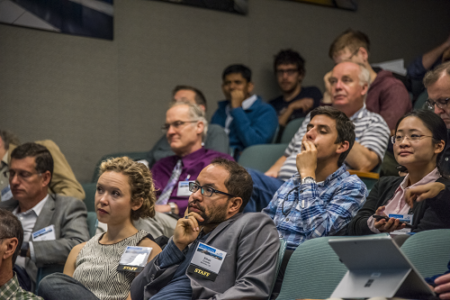
Simon Bare, a scientist at SLAC’s Stanford Synchrotron Radiation Lightsource (SSRL), spoke about SSRL’s mission to evolve into a premier hard x-ray facility with a strategic focus on catalyst science. Bare pointed out opportunities for the ALS and SSRL to collaborate and gave numerous examples of researchers who are already using both facilities.
John Turner, from the National Renewable Energy Laboratory (NREL), was up next with a lively presentation about semiconductor systems and catalysis for photoelectrochemical (PEC) water splitting. In the search for sustainable paths to hydrogen for fuel, ammonia, and energy storage, economics is the final determination, said Turner, and the cost of hydrogen is mainly determined by the cost of electricity. Turner has focused his research on molecular catalysts for PEC water splitting, in an effort to build higher-efficiency water splitting devices.
Ilan Gur, founder and executive director of Berkeley Lab’s scientific innovation hub Cyclotron Road, rounded out the morning with his talk about Cyclotron Road’s mission and accomplishments in its first years. The program started in 2014 with a focus on tying together basic science and applied work, giving scientists with commercially viable ideas a place to develop them alongside the tools and support of Berkeley Lab. Given an entrepreneurial research fellowship for two years and a bit of seed funding, everyone within Cyclotron Road’s first cohort turned their project into a prototype for a company. The cohort attracted $10 million in additional R&D funding and $5 million in initial private investment in their new businesses.
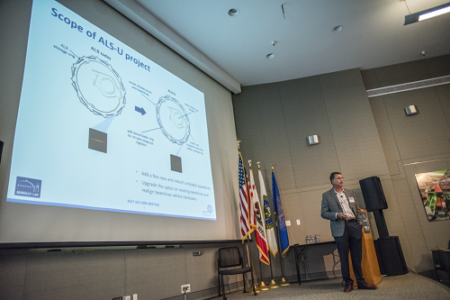
Monday afternoon continued with an update on the ALS Upgrade project (ALS-U) from Project Director Dave Robin and ALS Deputy for Science Steve Kevan. Robin spoke on recent project progress, including R&D and headway on the conceptual design. Kevan highlighted science opportunities presented by ALS-U that were discussed at a workshop earlier this year and detailed ways users can be involved in an important next phase of the project—the selection process for new and rebuilt beamlines that will be included in the project.
ALS Staff Scientist David Shapiro spoke about ptychography at the ALS. A coherent diffractive imaging technique based on high-performance scanning transmission x-ray microscopy (STXM), ptychography has the potential to revolutionize how we see nanoscale materials. Coherent imaging is a key technique that will benefit from the improved capabilities of ALS-U.
User Services Group Leader Sue Bailey gave an update on the new ALS centralized scheduling system and the new experiment safety form. Fernando Sannibale, ALS division deputy for accelerator operations and development, reviewed ALS accelerator, instrumentation, and controls upgrades.
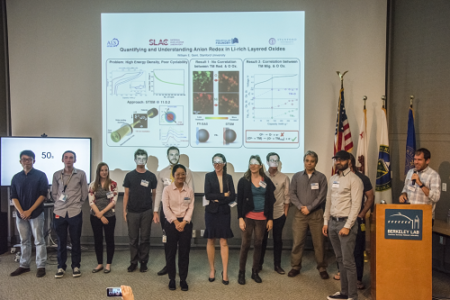
The afternoon concluded with the annual poster session, open to all User Meeting attendees, and student poster competition, which recognizes significant student research conducted at the ALS. Students presented their posters on a wide variety of topics, with first prize going to Natalie Larson, from UC Santa Barbara, for her poster “In-situ x-ray computed tomography of defect evolution during polymer impregnation and pyrolysis processing of ceramic matrix composites.” Second prize went to Jessica Thomaston (UC San Francisco) for “X-ray crystal structures of the influenza A M2 proton channel bound to amantadine, rimantadine, and inhibitors.” Sam Schickler (Lick Wilmerding High School) was awarded third prize for “Using virtual reality to visualize 3D micron-scale data at the macro scale.” Watch the poster slam presentations by all three winners here.
Tuesday morning began with a talk from Miquel Salmeron, a senior staff scientist in Berkeley Lab’s Materials Sciences Division, about how spectroscopies provide information on the electronic structure of surfaces, with a focus on solid–gas and solid–liquid interfaces. Student poster award winner Natalie Larson followed with a presentation on the research behind her award-winning poster. Larson is investigating shrinkage cracking during pyrolysis in ceramic matrix composites at the ALS.
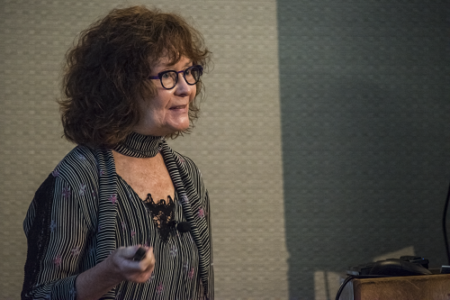
This year’s Shirley Award winner, Carolyn Larabell of the Molecular Biophysics and Integrated Bioimaging Division, spoke about her work pioneering soft x-ray tomography for imaging cells in their fully hydrated, functional state, and establishing the National Center for X-Ray Tomography, a world-leading research facility centered around ALS Beamline 2.1.
Tuesday’s scientific speaker lineup included Eva M. Herzig from Universität Bayreuth, speaking about in situ characterization of thin-film formation using grazing incidence x-ray scattering; NIST’s Alex Grutter talking about emergent phenomena at magnetic interfaces; Aarhus University’s Søren Ulstrup speaking about electronic properties of 2D heterostructures from MAESTRO’s micro- and nanoARPES at the ALS; and Marie Jackson from the University of Utah presenting her ALS beamline investigations of Roman concrete and its geologic analog at the Surtsey volcano in Iceland.
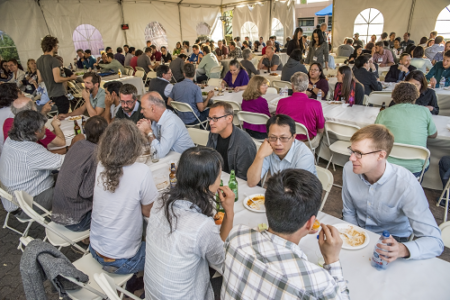
The second day of the 2017 User Meeting concluded with the annual awards dinner. The Klaus Halbach Award for Innovative Instrumentation at the ALS was awarded to the ALS’s Dmitriy Voronov for pioneering work in the area of advanced x-ray gratings. The Tim Renner User Services Award went to Sue Bailey for her leadership in developing the ALS user portal—ALSHub—and its associated software suite. The two were joined by Shirley Award winner Larabell and Student Award winner Larson.
Watch User Meeting attendees talk about their experiences at this year’s meeting